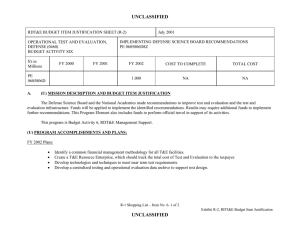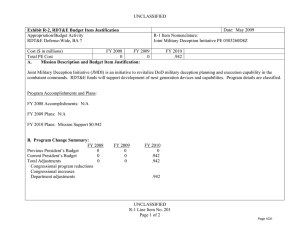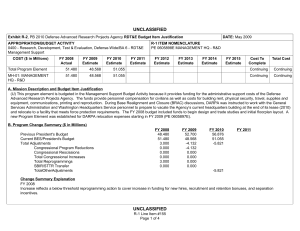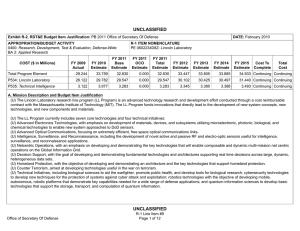UNCLASSIFIED
advertisement
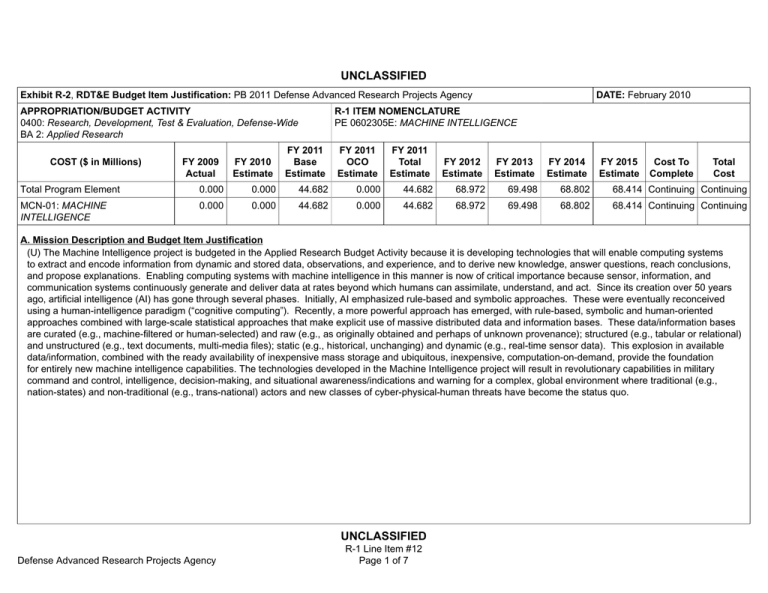
UNCLASSIFIED Exhibit R-2, RDT&E Budget Item Justification: PB 2011 Defense Advanced Research Projects Agency APPROPRIATION/BUDGET ACTIVITY 0400: Research, Development, Test & Evaluation, Defense-Wide BA 2: Applied Research COST ($ in Millions) FY 2009 Actual DATE: February 2010 R-1 ITEM NOMENCLATURE PE 0602305E: MACHINE INTELLIGENCE FY 2010 Estimate FY 2011 Base Estimate FY 2011 OCO Estimate FY 2011 Total Estimate FY 2012 Estimate FY 2013 Estimate FY 2014 Estimate FY 2015 Estimate Cost To Complete Total Cost Total Program Element 0.000 0.000 44.682 0.000 44.682 68.972 69.498 68.802 68.414 Continuing Continuing MCN-01: MACHINE INTELLIGENCE 0.000 0.000 44.682 0.000 44.682 68.972 69.498 68.802 68.414 Continuing Continuing A. Mission Description and Budget Item Justification (U) The Machine Intelligence project is budgeted in the Applied Research Budget Activity because it is developing technologies that will enable computing systems to extract and encode information from dynamic and stored data, observations, and experience, and to derive new knowledge, answer questions, reach conclusions, and propose explanations. Enabling computing systems with machine intelligence in this manner is now of critical importance because sensor, information, and communication systems continuously generate and deliver data at rates beyond which humans can assimilate, understand, and act. Since its creation over 50 years ago, artificial intelligence (AI) has gone through several phases. Initially, AI emphasized rule-based and symbolic approaches. These were eventually reconceived using a human-intelligence paradigm (“cognitive computing”). Recently, a more powerful approach has emerged, with rule-based, symbolic and human-oriented approaches combined with large-scale statistical approaches that make explicit use of massive distributed data and information bases. These data/information bases are curated (e.g., machine-filtered or human-selected) and raw (e.g., as originally obtained and perhaps of unknown provenance); structured (e.g., tabular or relational) and unstructured (e.g., text documents, multi-media files); static (e.g., historical, unchanging) and dynamic (e.g., real-time sensor data). This explosion in available data/information, combined with the ready availability of inexpensive mass storage and ubiquitous, inexpensive, computation-on-demand, provide the foundation for entirely new machine intelligence capabilities. The technologies developed in the Machine Intelligence project will result in revolutionary capabilities in military command and control, intelligence, decision-making, and situational awareness/indications and warning for a complex, global environment where traditional (e.g., nation-states) and non-traditional (e.g., trans-national) actors and new classes of cyber-physical-human threats have become the status quo. UNCLASSIFIED Defense Advanced Research Projects Agency R-1 Line Item #12 Page 1 of 7 UNCLASSIFIED Exhibit R-2, RDT&E Budget Item Justification: PB 2011 Defense Advanced Research Projects Agency APPROPRIATION/BUDGET ACTIVITY 0400: Research, Development, Test & Evaluation, Defense-Wide BA 2: Applied Research B. Program Change Summary ($ in Millions) Previous President's Budget Current President's Budget Total Adjustments • Congressional General Reductions • Congressional Directed Reductions • Congressional Rescissions • Congressional Adds • Congressional Directed Transfers • Reprogrammings • SBIR/STTR Transfer • TotalOtherAdjustments DATE: February 2010 R-1 ITEM NOMENCLATURE PE 0602305E: MACHINE INTELLIGENCE FY 2009 0.000 0.000 0.000 0.000 0.000 0.000 0.000 FY 2010 0.000 0.000 0.000 0.000 0.000 0.000 0.000 0.000 0.000 0.000 0.000 FY 2011 Base 0.000 44.682 44.682 FY 2011 OCO 0.000 0.000 0.000 FY 2011 Total 0.000 44.682 44.682 44.682 0.000 44.682 Change Summary Explanation FY 2011 Not Applicable C. Accomplishments/Planned Program ($ in Millions) FY 2009 Machine Reading and Reasoning Technology 0.000 (U) The Machine Reading and Reasoning Technology program (previously funded in PE 0602304E, Project COG-02) will develop enabling technologies to acquire, integrate, and use high performance reasoning strategies in knowledge-rich domains. Such technologies will provide DoD decision makers with rapid, relevant knowledge from a broad spectrum of sources that may be dynamic and/ or inconsistent. To address the significant challenges of context, temporal information, complex belief structures, and uncertainty, new capabilities are needed to extract key information and metadata, and to exploit these via context-capable search and inference. Cognitive inference has traditionally UNCLASSIFIED Defense Advanced Research Projects Agency R-1 Line Item #12 Page 2 of 7 FY 2010 0.000 FY 2011 Base 23.896 FY 2011 OCO 0.000 FY 2011 Total 23.896 UNCLASSIFIED Exhibit R-2, RDT&E Budget Item Justification: PB 2011 Defense Advanced Research Projects Agency APPROPRIATION/BUDGET ACTIVITY 0400: Research, Development, Test & Evaluation, Defense-Wide BA 2: Applied Research DATE: February 2010 R-1 ITEM NOMENCLATURE PE 0602305E: MACHINE INTELLIGENCE C. Accomplishments/Planned Program ($ in Millions) FY 2009 emphasized deduction via theorem-proving and induction via statistical techniques, but abduction — also known as “inference to the best explanation”— is also likely to play a large role. DoD systems sense, capture, and store information in the form of text, audio, imagery, and video, and so advanced machine reasoning capabilities must extract knowledge from, and reason about, all types of multimedia data. New visual faculties will enable cognitive systems to learn from visual experience, to reason about action in the real world, and to apply that knowledge in a broad range of domains to solve problems in tactical and security contexts. (U) Machine Reading addresses the prohibitive cost of handcrafting information by replacing the expert, and associated knowledge engineer, with un-supervised or self-supervised learning systems, systems that “read” natural text and insert it into AI knowledge bases, i.e. data stores especially encoded to support subsequent machine reasoning. Machine Reading requires the integration of multiple technologies: natural language processing must be used to transform the text into candidate internal representations, and knowledge representation and reasoning techniques must be used to test this new information to determine how it is to be integrated into the system’s evolving models so that it can be used for effective problem solving. FY 2011 Base Plans: - Extend knowledge extraction capabilities of machine reading systems to acquire simple relationship information in addition to factual data. - Force generality of machine reading systems through introduction of multiple, hidden domains. - Develop knowledge extraction, representation, and reasoning capabilities to support spatial, complex temporal, and event reasoning. - Develop an abductive inference system that discovers explanatory relationships between formal assertions without need of formal proof. - Integrate new visual reasoning components into a complete architecture that combines visual concept learning, analysis, and imagination with facilities for low-level visual processing, cognition, and user/system interfaces. UNCLASSIFIED Defense Advanced Research Projects Agency R-1 Line Item #12 Page 3 of 7 FY 2010 FY 2011 Base FY 2011 OCO FY 2011 Total UNCLASSIFIED Exhibit R-2, RDT&E Budget Item Justification: PB 2011 Defense Advanced Research Projects Agency APPROPRIATION/BUDGET ACTIVITY 0400: Research, Development, Test & Evaluation, Defense-Wide BA 2: Applied Research DATE: February 2010 R-1 ITEM NOMENCLATURE PE 0602305E: MACHINE INTELLIGENCE C. Accomplishments/Planned Program ($ in Millions) FY 2009 Web-Scale Information Integration 0.000 (U) The Web-Scale Information Integration program (formerly funded as Cloud Computing in PE 0602304E, Project COG-03) will create technologies to automatically integrate distributed information bases for broad strategic and tactical battlespace awareness, including technologies to automate the integration of multiple media (text, video, and digital photographs) as well as analyze, index, and store that media, so that it can be easily queried and retrieved by users across the DoD enterprise. A key enabler is the creation of a network-based repository that provides a mechanism for the virtual (i.e., logical, not physical) centralization of all enterprise information. This concept is well-aligned with important developments in the commercial sector related to cloud computing, which makes computing resources and services readily available over the Internet (“public cloud”) or enterprise intranet (“private cloud”). Inherent to such ubiquitous availability of enterprise data is the need for strong security including fine-grained/role-based controls that enable and facilitate access only to approved and authenticated users. A second key enabler is the development of advanced document/ content/information-object services including indexing, metadata creation, search, versioning, records management, schema alignment, and information visualization. Program interest extends to semantic web technologies whereby the semantics of information and services are made explicit, enabling machines to understand and satisfy the information requests of users (people and machines). This will provide the basis for semantically-enabled search and processing capabilities that automate information discovery and manipulation. The Web-Scale Information Integration program will also create a new suite of intelligent information integration tools that will learn to automatically understand heterogeneous information systems and integrate them into the existing information environment. In this fashion the Web-Scale Information Integration program will enable virtual interoperability of information systems that are currently stovepiped. The result will be more complete and reliable information as the basis for better decision-making for warfighters. UNCLASSIFIED Defense Advanced Research Projects Agency R-1 Line Item #12 Page 4 of 7 FY 2010 0.000 FY 2011 Base 13.786 FY 2011 OCO 0.000 FY 2011 Total 13.786 UNCLASSIFIED Exhibit R-2, RDT&E Budget Item Justification: PB 2011 Defense Advanced Research Projects Agency APPROPRIATION/BUDGET ACTIVITY 0400: Research, Development, Test & Evaluation, Defense-Wide BA 2: Applied Research DATE: February 2010 R-1 ITEM NOMENCLATURE PE 0602305E: MACHINE INTELLIGENCE C. Accomplishments/Planned Program ($ in Millions) FY 2009 FY 2010 FY 2011 Base FY 2011 OCO FY 2011 Total FY 2011 Base Plans: - Conceptualize a distributed information architecture that can scale to petabytes of storage, quadrillions of objects and metadata tags, tens of thousands of network nodes, and millions of enduser processors. - Develop highly efficient techniques for metadata extraction, user modeling, network pre-positioning of information resources, provenance tracking, and version control. - Integrate dialogue system with semantically-enabled search capabilities to enable intelligent, userdefined Web search routines. - Link dialogue semantics with learning-by-demonstration techniques to produce reusable and composable Web search and content manipulation services. - Develop ability to align disparate data sources to provide a centralized query capability and construct an interactive visualization to increase an analyst’s understanding of the disparate data sources. - Construct a small-scale testbed on which to conduct testing with actual military information systems and a variety of new data sources of increasing complexity. Large-Scale Asymmetric Systems 0.000 (U) The Large-Scale Asymmetric Systems program will develop intelligent situational assessment technologies that will enable us to understand, anticipate, prevent and counter current, emerging, and potential threats to our military at the global, regional and local scales. Examples of such threats include emerging regional peer rivals, rogue and failed nation-states, insurgent groups, militant/ radicalized populations, and trans-national terrorist organizations and criminal enterprises. An intelligent situation assessment system would process and integrate data/information from physical sensors and non-physical sources to derive the likely probabilities of the range of outcomes for a variety of interactions involving complex cyber-physical-human networks. In addition, an intelligent situation assessment system would provide indications and warning of asymmetric threats while they are still at the stage where they can be managed by peaceful means and before they require a military response. Large-Scale Asymmetric Systems will use cognitive and computational technologies to UNCLASSIFIED Defense Advanced Research Projects Agency R-1 Line Item #12 Page 5 of 7 0.000 7.000 0.000 7.000 UNCLASSIFIED Exhibit R-2, RDT&E Budget Item Justification: PB 2011 Defense Advanced Research Projects Agency APPROPRIATION/BUDGET ACTIVITY 0400: Research, Development, Test & Evaluation, Defense-Wide BA 2: Applied Research DATE: February 2010 R-1 ITEM NOMENCLATURE PE 0602305E: MACHINE INTELLIGENCE C. Accomplishments/Planned Program ($ in Millions) FY 2009 FY 2010 FY 2011 Base FY 2011 OCO FY 2011 Total produce quantitative and qualitative models that enable the assessment of alternative courses of action and anticipation of system dynamics including diplomatic, information, military, and economic (DIME) actions. This will include the development of operationally relevant social science theories, in a disciplined and cumulative manner, to support decision making at the strategic and operational levels, and the creation of a large body of test cases against which integrated social science theories can be evaluated. In this way Large-Scale Asymmetric Systems will provide military leaders with the capability to realistically monitor, assess, and forecast in near-real time how global events and U.S. actions are affecting the behaviors of leaders, groups, and institutions in religiously, ethnically, and culturally diverse societies around the world. FY 2011 Base Plans: - Create learning models for dynamic cyber-physical-human networks that include foreign political, military, and popular leaders. - Demonstrate the feasibility of acquiring and maintaining cyber-physical-human dynamics data in near-real-time and of extracting reliable indications and warning. - Assess the potential of human, social, cultural, and behavioral theories to explain and predict the behaviors of foreign leaders and organizations. - Develop techniques for inferring a leader’s intentions and actions based upon past behavior and statements and the socio-cultural environment. Accomplishments/Planned Programs Subtotals D. Other Program Funding Summary ($ in Millions) N/A E. Acquisition Strategy N/A UNCLASSIFIED Defense Advanced Research Projects Agency R-1 Line Item #12 Page 6 of 7 0.000 0.000 44.682 0.000 44.682 UNCLASSIFIED Exhibit R-2, RDT&E Budget Item Justification: PB 2011 Defense Advanced Research Projects Agency APPROPRIATION/BUDGET ACTIVITY 0400: Research, Development, Test & Evaluation, Defense-Wide BA 2: Applied Research R-1 ITEM NOMENCLATURE PE 0602305E: MACHINE INTELLIGENCE F. Performance Metrics Specific programmatic performance metrics are listed above in the program accomplishments and plans section. UNCLASSIFIED Defense Advanced Research Projects Agency R-1 Line Item #12 Page 7 of 7 DATE: February 2010
